sensor LEXUS LS430 2003 Factory User Guide
[x] Cancel search | Manufacturer: LEXUS, Model Year: 2003, Model line: LS430, Model: LEXUS LS430 2003Pages: 4500, PDF Size: 87.45 MB
Page 21 of 4500
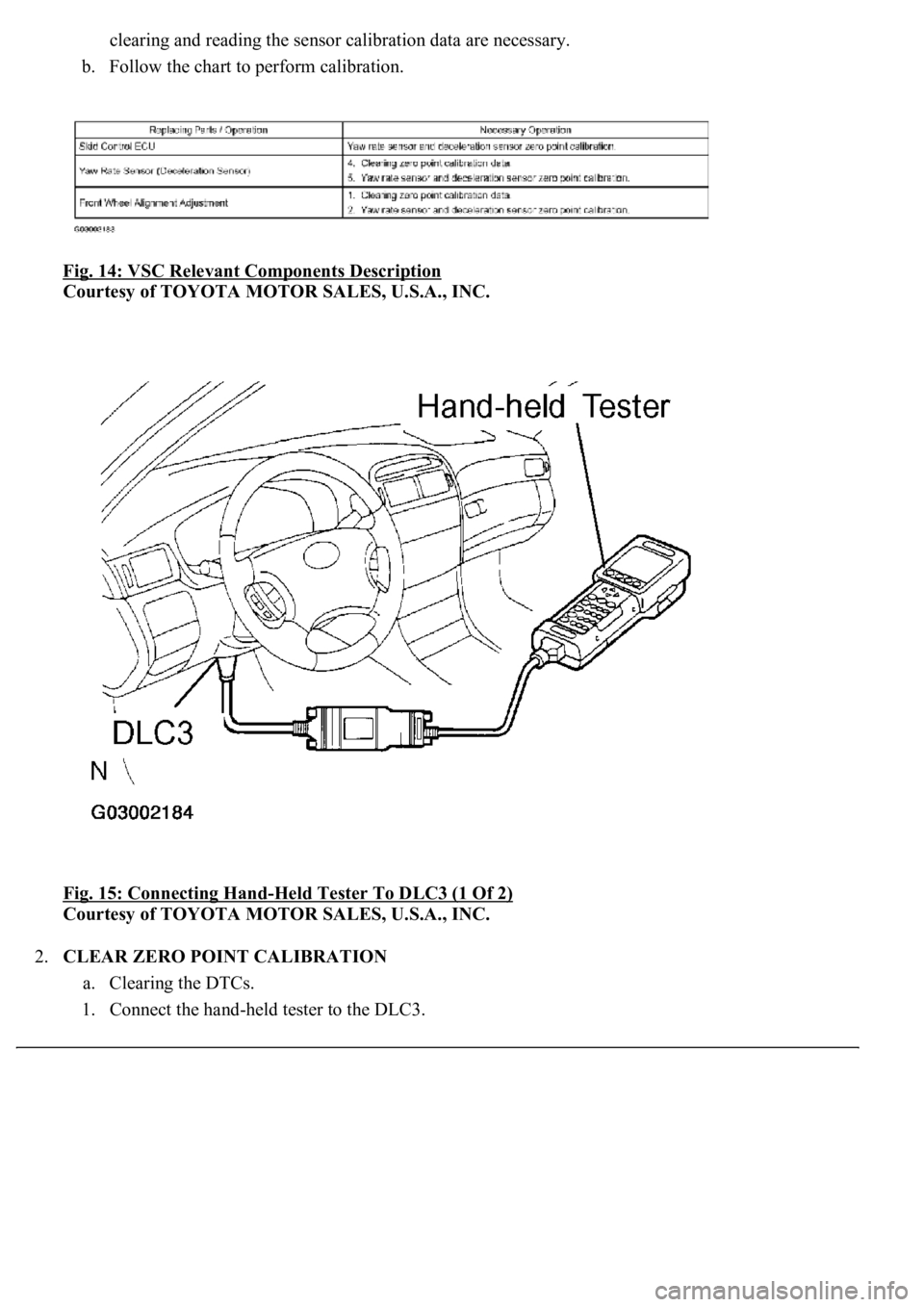
clearing and reading the sensor calibration data are necessary.
b. Follow the chart to perform calibration.
Fig. 14: VSC Relevant Components Description
Courtesy of TOYOTA MOTOR SALES, U.S.A., INC.
Fig. 15: Connecting Hand
-Held Tester To DLC3 (1 Of 2)
Courtesy of TOYOTA MOTOR SALES, U.S.A., INC.
2.CLEAR ZERO POINT CALIBRATION
a. Clearing the DTCs.
1. Connect the han
d-held tester to the DLC3.
Page 22 of 4500
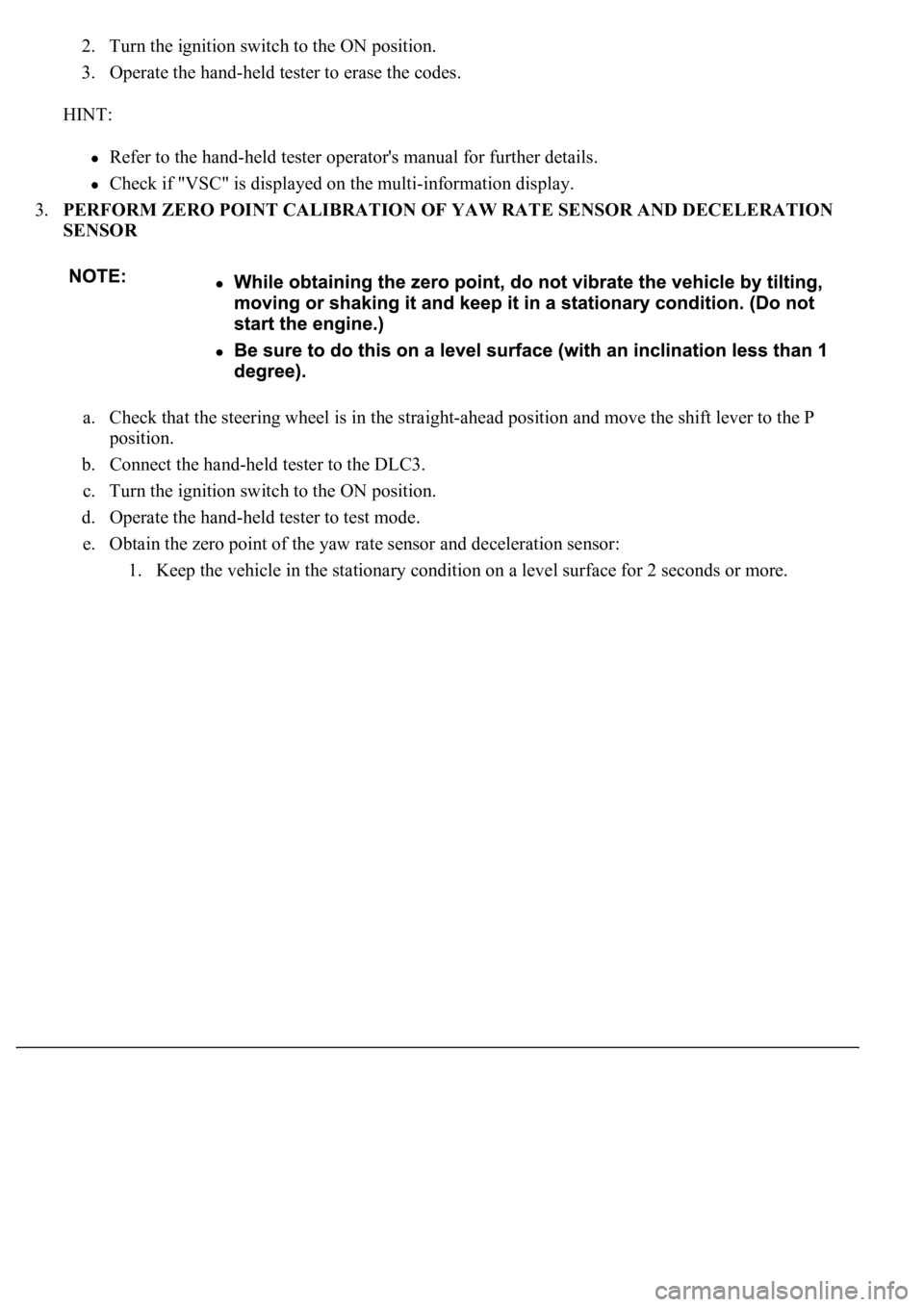
2. Turn the ignition switch to the ON position.
3. Operate the hand-held tester to erase the codes.
HINT:
Refer to the hand-held tester operator's manual for further details.
Check if "VSC" is displayed on the multi-information display.
3.PERFORM ZERO POINT CALIBRATION OF YAW RATE SENSOR AND DECELERATION
SENSOR
a. Check that the steering wheel is in the straight-ahead position and move the shift lever to the P
position.
b. Connect the hand-held tester to the DLC3.
c. Turn the ignition switch to the ON position.
d. Operate the hand-held tester to test mode.
e. Obtain the zero point of the yaw rate sensor and deceleration sensor:
1. Keep the vehicle in the stationar
y condition on a level surface for 2 seconds or more.
Page 27 of 4500
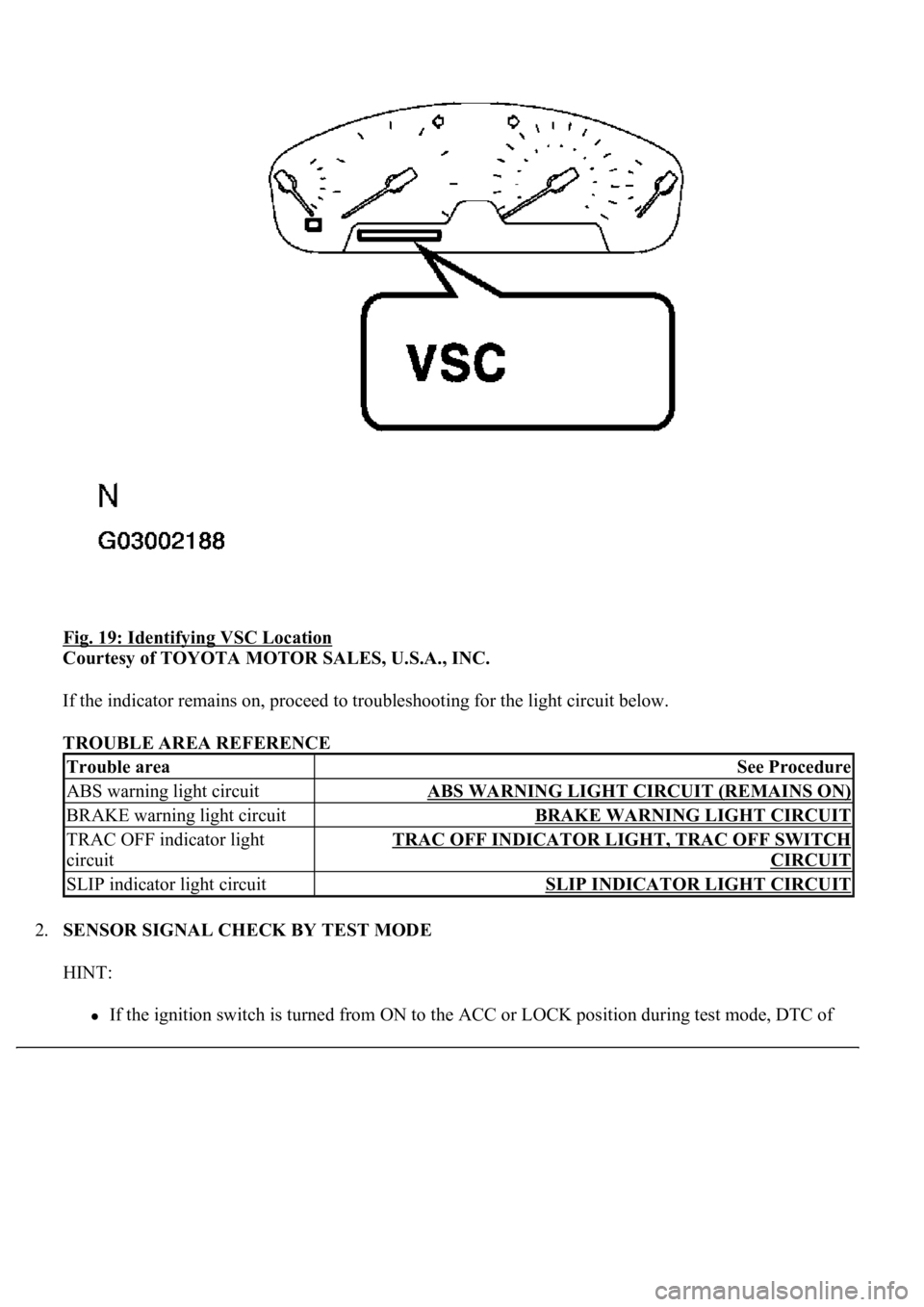
Fig. 19: Identifying VSC Location
Courtesy of TOYOTA MOTOR SALES, U.S.A., INC.
If the indicator remains on, proceed to troubleshooting for the light circuit below.
TROUBLE AREA REFERENCE
2.SENSOR SIGNAL CHECK BY TEST MODE
HINT:
If the ignition switch is turned from ON to the ACC or LOCK position during test mode, DTC of
Trouble areaSee Procedure
ABS warning light circuitABS WARNING LIGHT CIRCUIT (REMAINS ON)
BRAKE warning light circuitBRAKE WARNING LIGHT CIRCUIT
TRAC OFF indicator light
circuitTRAC OFF INDICATOR LIGHT, TRAC OFF SWITCH
CIRCUIT
SLIP indicator light circuitSLIP INDICATOR LIGHT CIRCUIT
Page 28 of 4500
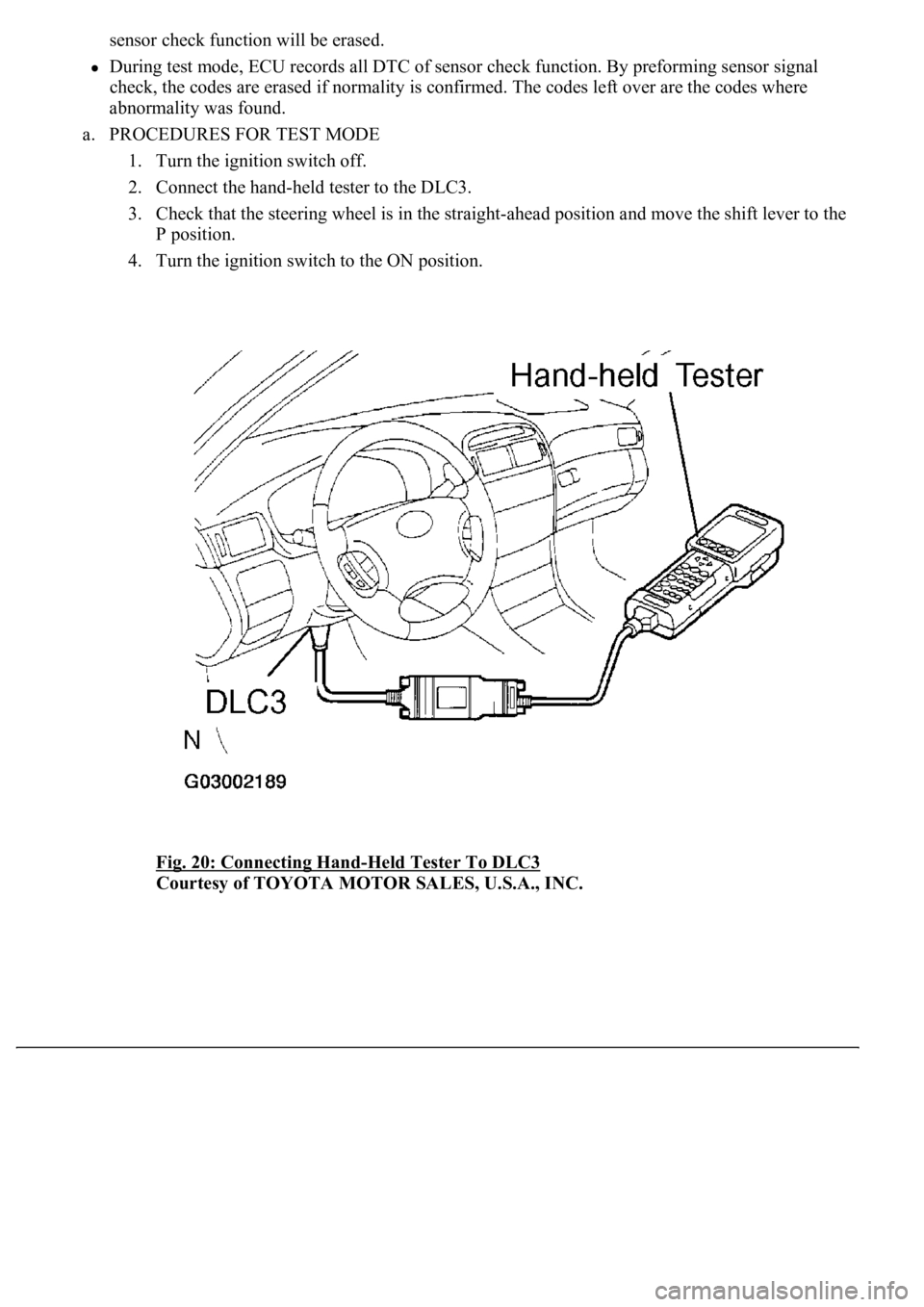
sensor check function will be erased.
<002700580055004c0051004a0003005700480056005700030050005200470048000f00030028002600380003005500480046005200550047005600030044004f004f0003002700370026000300520049000300560048005100560052005500030046004b00
480046004e000300490058005100460057004c005200510011[ By preforming sensor signal
check, the codes are erased if normality is confirmed. The codes left over are the codes where
abnormality was found.
a. PROCEDURES FOR TEST MODE
1. Turn the ignition switch off.
2. Connect the hand-held tester to the DLC3.
3. Check that the steering wheel is in the straight-ahead position and move the shift lever to the
P position.
4. Turn the ignition switch to the ON position.
Fig. 20: Connecting Hand
-Held Tester To DLC3
Courtesy of TOYOTA MOTOR SALES, U.S.A., INC.
Page 29 of 4500
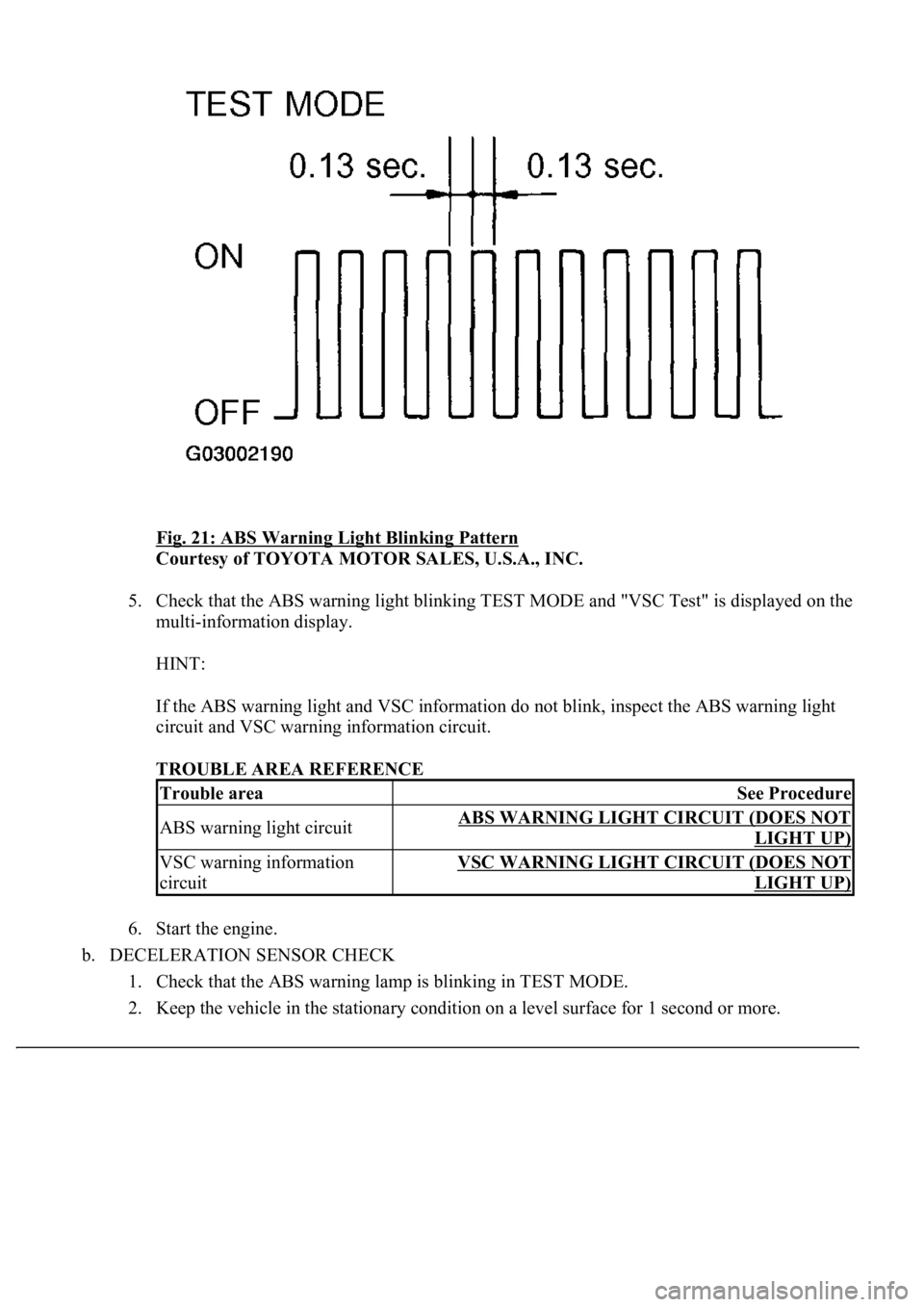
Fig. 21: ABS Warning Light Blinking Pattern
Courtesy of TOYOTA MOTOR SALES, U.S.A., INC.
5. Check that the ABS warning light blinking TEST MODE and "VSC Test" is displayed on the
multi-information display.
HINT:
If the ABS warning light and VSC information do not blink, inspect the ABS warning light
circuit and VSC warning information circuit.
TROUBLE AREA REFERENCE
6. Start the engine.
b. DECELERATION SENSOR CHECK
1. Check that the ABS warning lamp is blinking in TEST MODE.
2. Keep the vehicle in the stationar
y<00030046005200510047004c0057004c00520051000300520051000300440003004f004800590048004f0003005600580055004900440046004800030049005200550003001400030056004800460052005100470003005200550003005000520055004800
110003[
Trouble areaSee Procedure
ABS warning light circuitABS WARNING LIGHT CIRCUIT (DOES NOT
LIGHT UP)
VSC warning information
circuitVSC WARNING LIGHT CIRCUIT (DOES NOT
LIGHT UP)
Page 30 of 4500
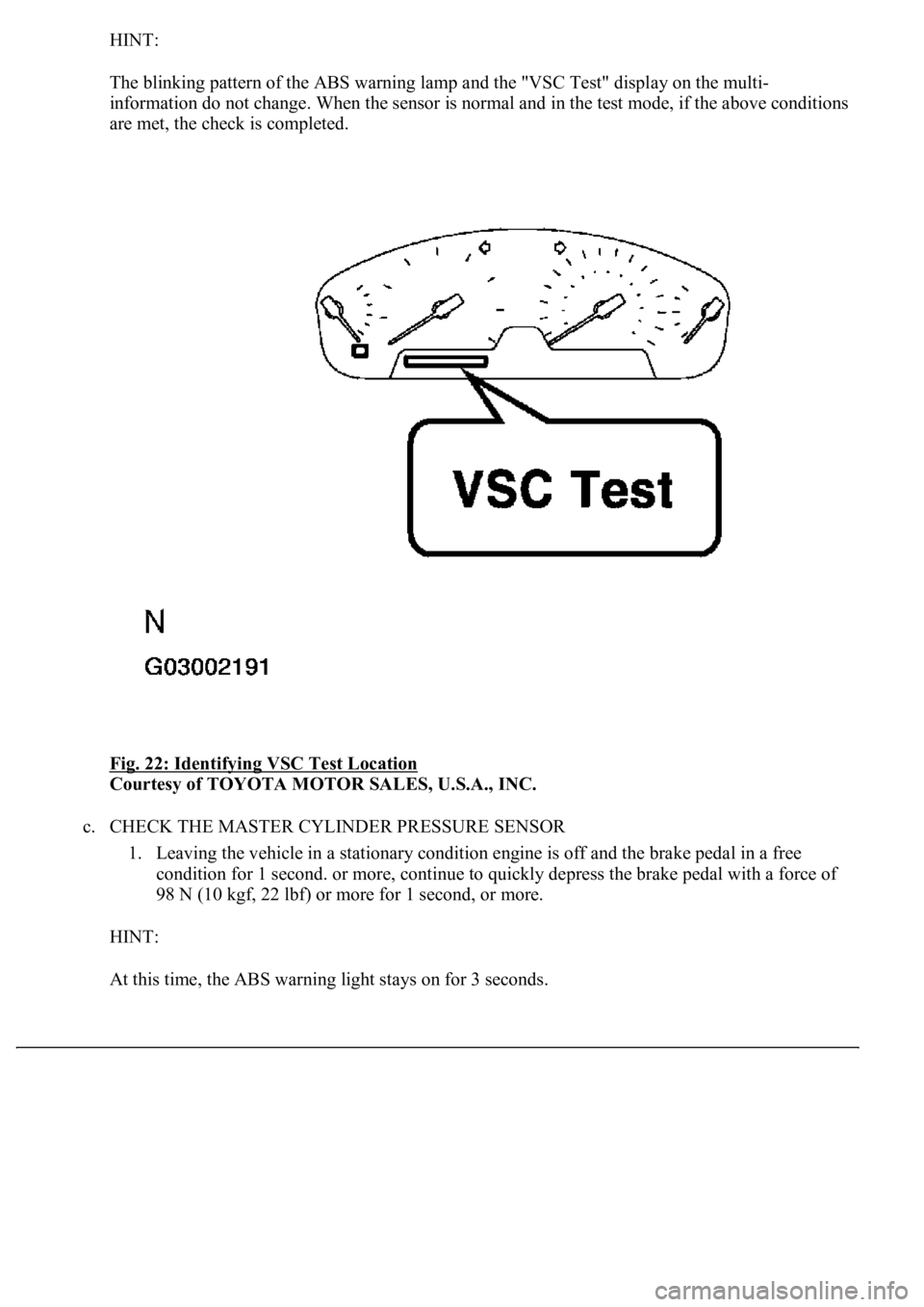
HINT:
The blinking pattern of the ABS warning lamp and the "VSC Test" display on the multi-
information do not change. When the sensor is normal and in the test mode, if the above conditions
are met, the check is completed.
Fig. 22: Identifying VSC Test Location
Courtesy of TOYOTA MOTOR SALES, U.S.A., INC.
c. CHECK THE MASTER CYLINDER PRESSURE SENSOR
1. Leaving the vehicle in a stationary condition engine is off and the brake pedal in a free
condition for 1 second. or more, continue to quickly depress the brake pedal with a force of
98 N (10 kgf, 22 lbf) or more for 1 second, or more.
HINT:
At this time, the ABS warnin
g light stays on for 3 seconds.
Page 31 of 4500
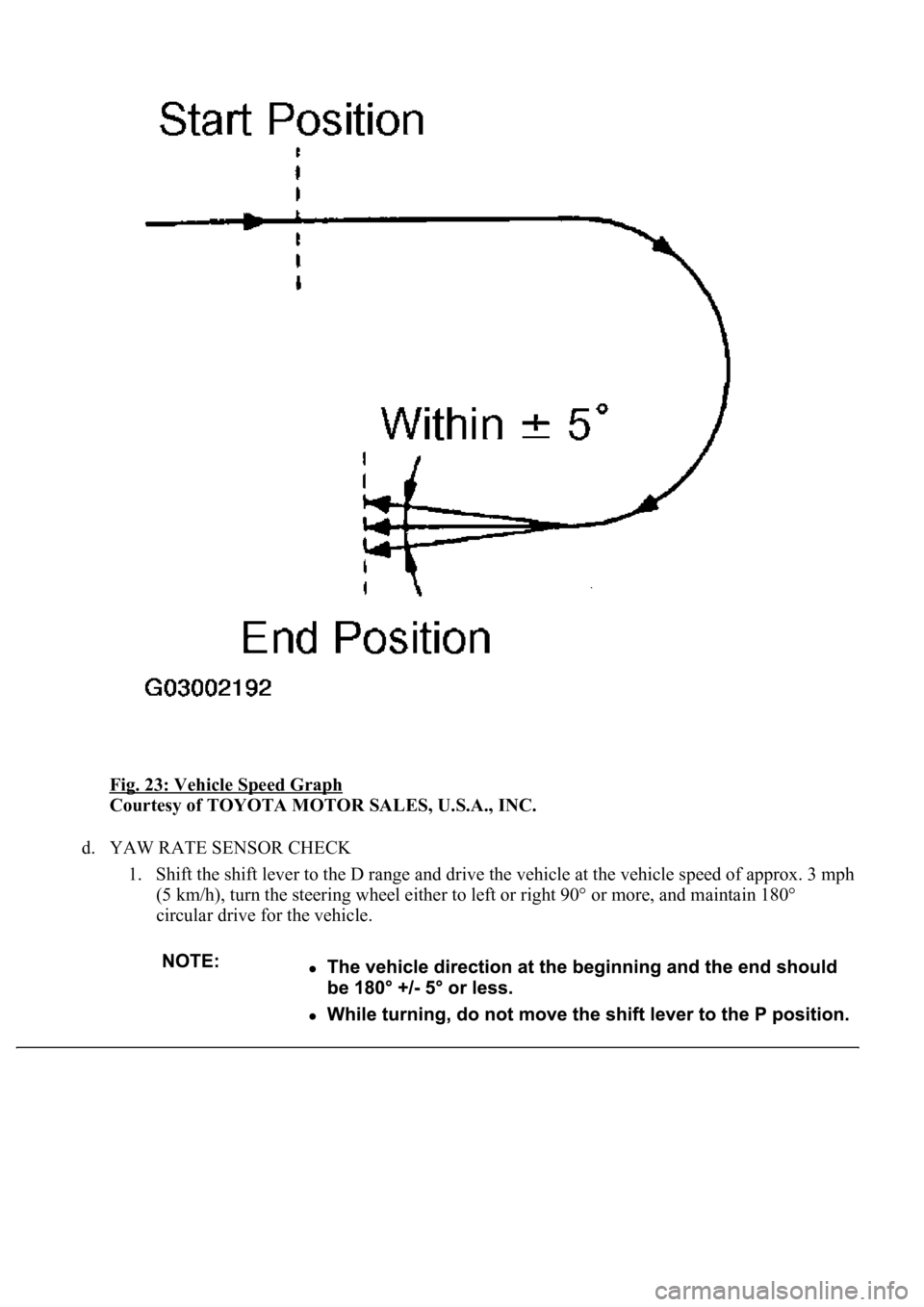
Fig. 23: Vehicle Speed Graph
Courtesy of TOYOTA MOTOR SALES, U.S.A., INC.
d. YAW RATE SENSOR CHECK
1. Shift the shift lever to the D range and drive the vehicle at the vehicle speed of approx. 3 mph
(5 km/h), turn the steering wheel either to left or right 90° or more, and maintain 180°
circular drive for the vehicle.
Page 32 of 4500
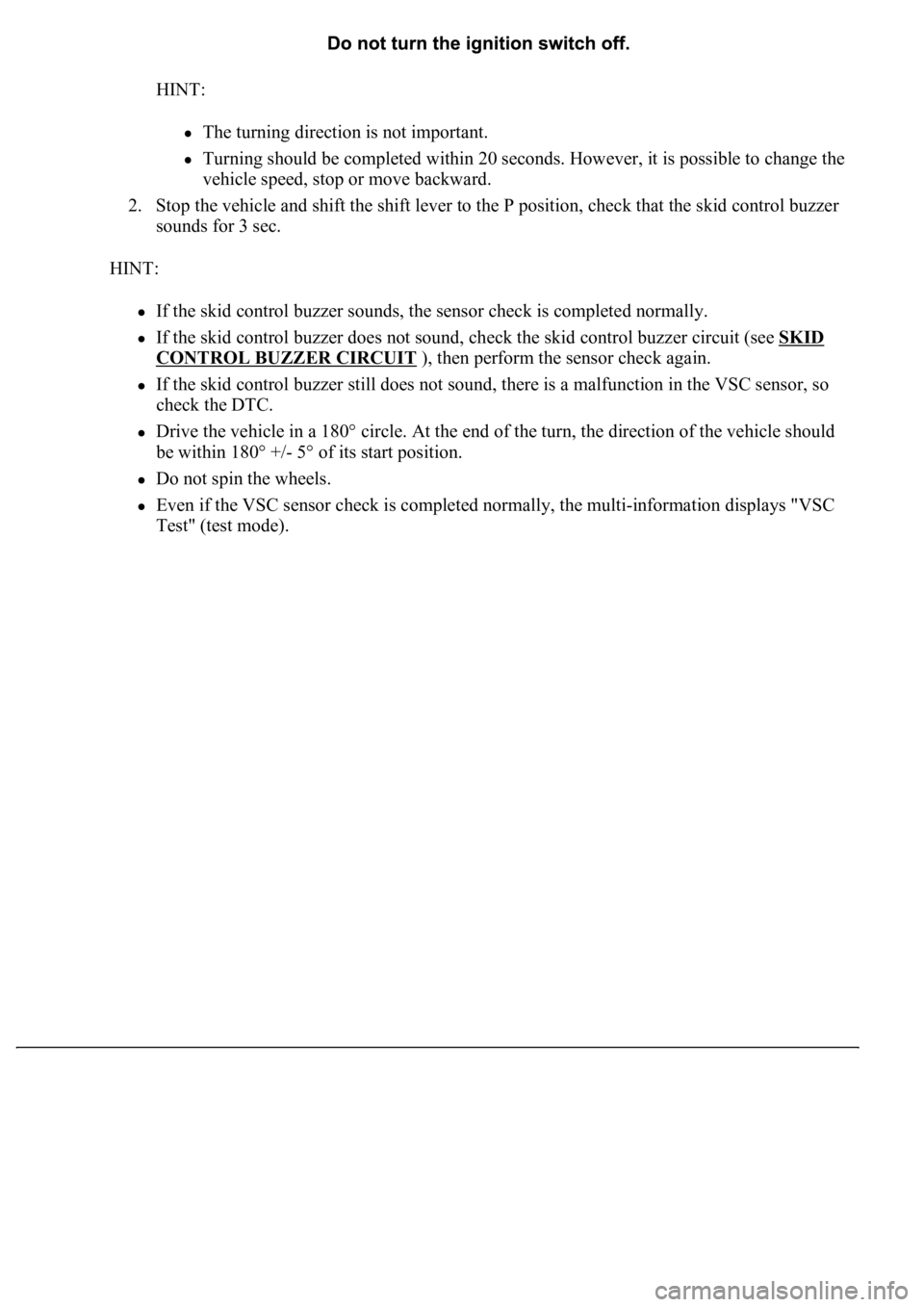
HINT:
The turning direction is not important.
Turning should be completed within 20 seconds. However, it is possible to change the
vehicle speed, stop or move backward.
2. Stop the vehicle and shift the shift lever to the P position, check that the skid control buzzer
sounds for 3 sec.
HINT:
If the skid control buzzer sounds, the sensor check is completed normally.
If the skid control buzzer does not sound, check the skid control buzzer circuit (see SKID
CONTROL BUZZER CIRCUIT ), then perform the sensor check again.
If the skid control buzzer still does not sound, there is a malfunction in the VSC sensor, so
check the DTC.
Drive the vehicle in a 180° circle. At the end of the turn, the direction of the vehicle should
be within 180° +/- 5° of its start position.
Do not spin the wheels.
Even if the VSC sensor check is completed normally, the multi-information displays "VSC
Test" (test mode).
Page 33 of 4500
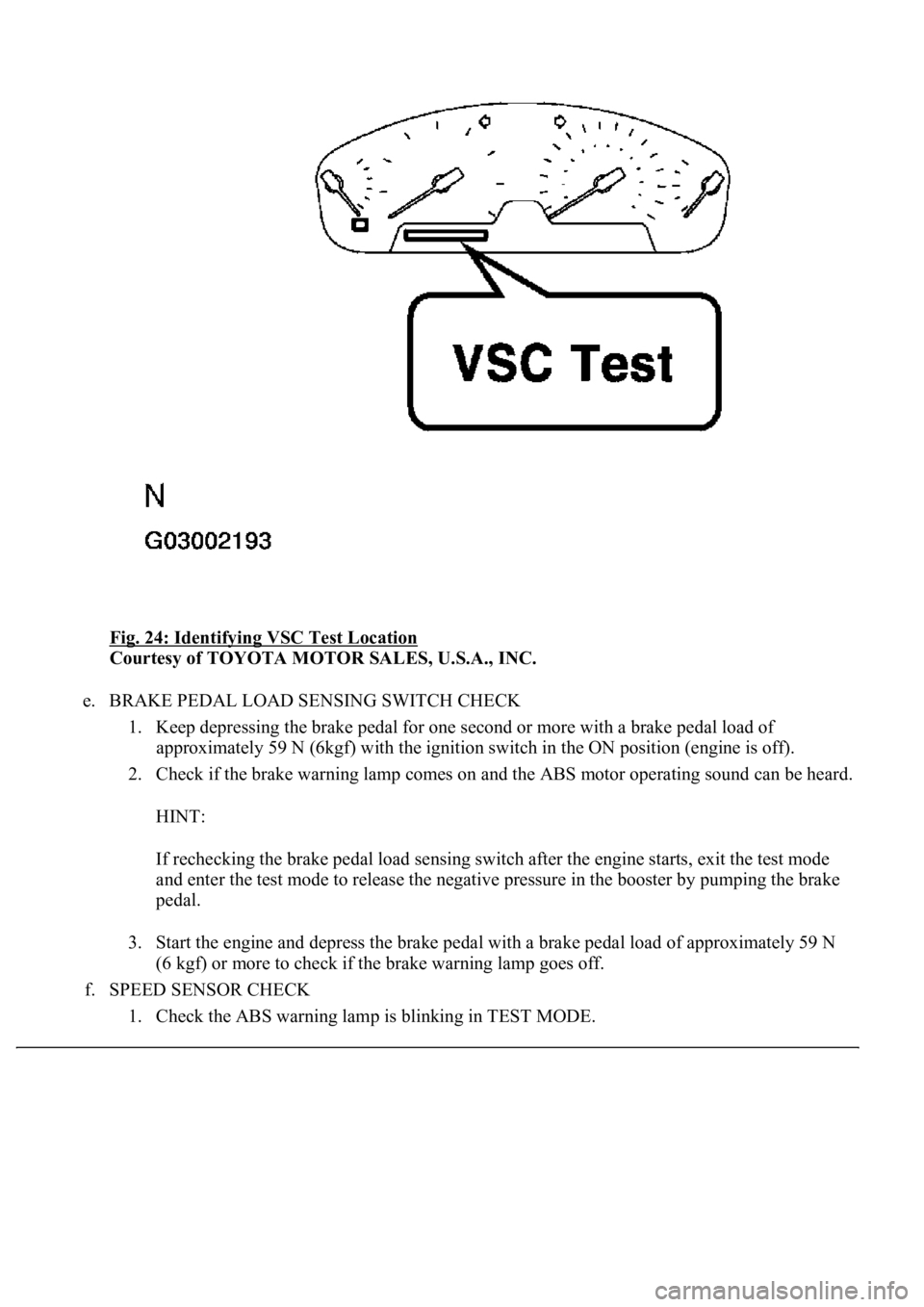
Fig. 24: Identifying VSC Test Location
Courtesy of TOYOTA MOTOR SALES, U.S.A., INC.
e. BRAKE PEDAL LOAD SENSING SWITCH CHECK
1. Keep depressing the brake pedal for one second or more with a brake pedal load of
approximately 59 N (6kgf) with the ignition switch in the ON position (engine is off).
2. Check if the brake warning lamp comes on and the ABS motor operating sound can be heard.
HINT:
If rechecking the brake pedal load sensing switch after the engine starts, exit the test mode
and enter the test mode to release the negative pressure in the booster by pumping the brake
pedal.
3. Start the engine and depress the brake pedal with a brake pedal load of approximately 59 N
(6 kgf) or more to check if the brake warning lamp goes off.
f. SPEED SENSOR CHECK
1. Check the ABS warnin
g lamp is blinking in TEST MODE.
Page 34 of 4500
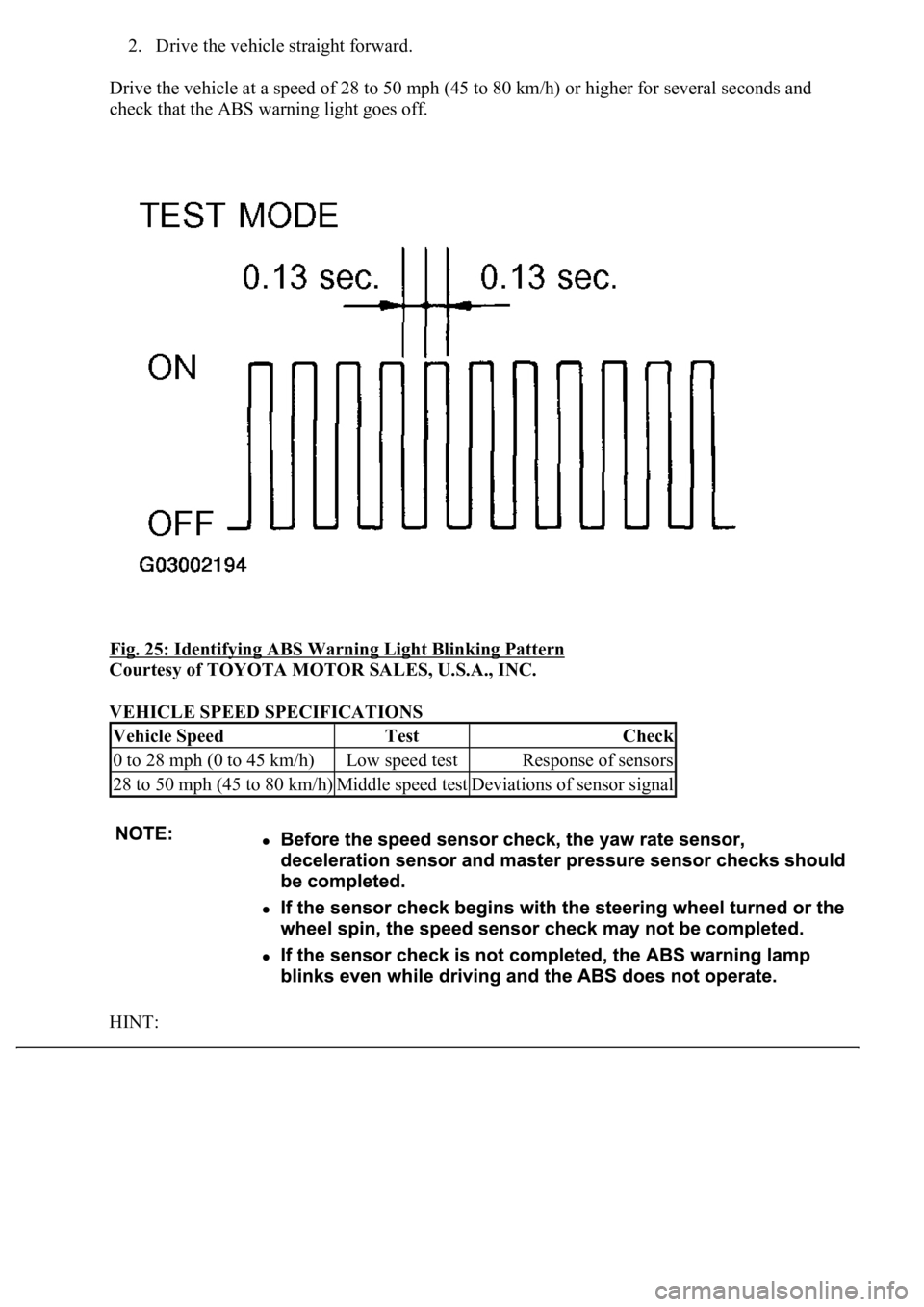
2. Drive the vehicle straight forward.
Drive the vehicle at a speed of 28 to 50 mph (45 to 80 km/h) or higher for several seconds and
check that the ABS warning light goes off.
Fig. 25: Identifying ABS Warning Light Blinking Pattern
Courtesy of TOYOTA MOTOR SALES, U.S.A., INC.
VEHICLE SPEED SPECIFICATIONS
HINT:
Vehicle SpeedTestCheck
0 to 28 mph (0 to 45 km/h)Low speed testResponse of sensors
28 to 50 mph (45 to 80 km/h)Middle speed testDeviations of sensor signal